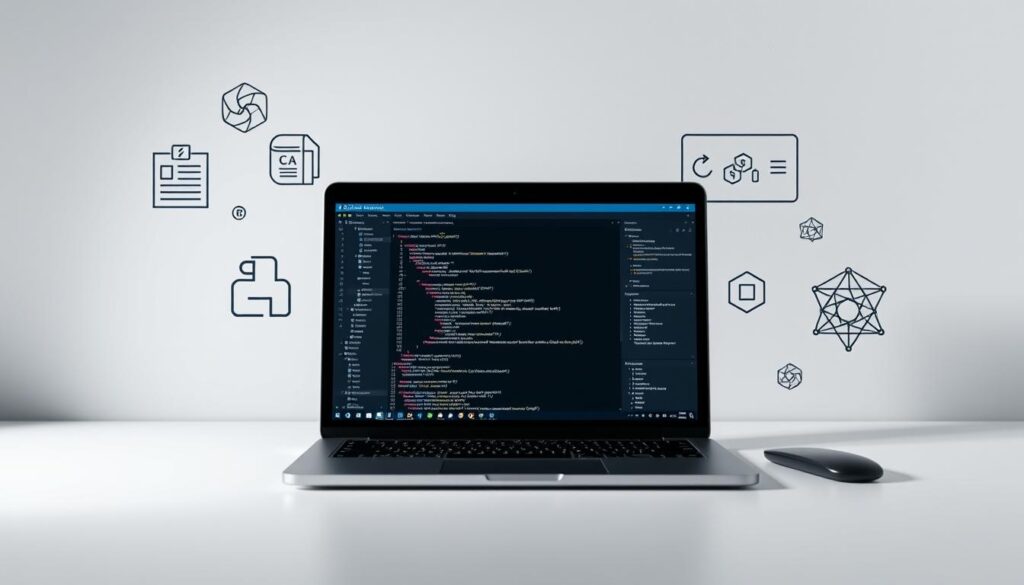Now Reading: Blockchain Development: Tools and Programming Languages
- 01
Blockchain Development: Tools and Programming Languages
Blockchain Development: Tools and Programming Languages

The digital landscape is evolving rapidly, with decentralized applications (DApps) reshaping industries from finance to supply chain. Modern creators now require specialized skills to navigate this transformative space, where smart contracts power everything from NFT marketplaces to automated governance systems.
Solidity remains the backbone of Ethereum-based solutions, while newer options like Rust and Vyper gain traction for specific use cases. Did you know? Over 65% of Web3 projects now prioritize cross-chain compatibility, demanding fluency in frameworks like Polkadot or Cosmos SDK.
This year’s developer surveys reveal three non-negotiable competencies: secure coding practices, interoperability understanding, and gas optimization techniques. Tools like Hardhat and Truffle Suite have become indispensable for testing and deployment, especially as Layer 2 solutions reduce transaction costs by up to 90%.
Key Takeaways
- Solidity dominates smart contract creation despite emerging alternatives
- Cross-platform compatibility is now a core industry requirement
- Security audits prevent 78% of potential exploits in DApps
- Gas-efficient coding reduces operational costs significantly
- Decentralized storage solutions complement mainnet operations
Understanding Blockchain Development Fundamentals
Blockchain technology reshapes how data is stored and verified by eliminating centralized control. At its core, it relies on distributed ledger technology, where information is shared across multiple nodes instead of a single server. This structure ensures transparency while preventing unauthorized changes.
How Blockchain Technology Works
Every blockchain operates through two critical elements: decentralized networks and consensus protocols. These components work together to validate transactions without intermediaries.
Decentralized Network Architecture
In a decentralized system, data isn’t stored in one location. Instead, copies of the ledger exist on thousands of devices worldwide. This setup enhances security because tampering with one node won’t alter the entire network. Node communication ensures all participants agree on the ledger’s current state through real-time updates.
Consensus models determine how networks validate transactions. The most common approaches include:
- Proof-of-Work (PoW): Used by Bitcoin, this method requires miners to solve complex math problems to add blocks.
- Proof-of-Stake (PoS): Ethereum’s energy-efficient alternative where validators “stake” coins to verify transactions.
Key Components of DApps
Decentralized applications (DApps) rely on smart contracts and peer-to-peer interactions to function autonomously. Platforms like Ethereum and Hyperledger Fabric provide frameworks for building these solutions.
Smart Contracts Explained
Smart contracts are self-executing agreements written in code. For example, Ethereum’s Solidity language lets developers create contracts that automatically release payments when conditions are met. Blockchain developers use these tools to build trustless systems for finance, supply chains, and more.
Peer-to-Peer Networking
DApps bypass centralized servers by connecting users directly. This node communication model reduces downtime and censorship risks. Hyperledger Fabric leverages this approach for enterprise-grade applications, ensuring data remains private yet verifiable through cryptographic hashing.
Essential Blockchain Development Tools and Programming Languages
Navigating the blockchain ecosystem requires balancing cutting-edge innovation with battle-tested reliability. Developers must evaluate tools and languages through two critical lenses: platform compatibility and security frameworks. The right development stack selection directly impacts a project’s scalability, interoperability, and long-term viability.
Criteria for Selecting Development Resources
When building blockchain solutions, consider these four factors:
- Cross-chain compatibility requirements
- Smart contract functionality needs
- Community support and documentation
- Enterprise-grade security features
Platform Compatibility Factors
Ethereum Virtual Machine (EVM) compatibility remains crucial for projects targeting DeFi ecosystems. Tools like Hardhat and Foundry dominate this space, offering seamless integration with Solidity. However, enterprise solutions like Hyperledger Fabric demand different approaches, favoring Go or Java for permissioned networks.
| Feature | EVM-Compatible | Enterprise Solutions |
|---|---|---|
| Smart Contract Language | Solidity/Vyper | Go/Java |
| Consensus Mechanism | Proof-of-Stake | Practical Byzantine Fault Tolerance |
| Interoperability | Cross-chain bridges | Private channel architecture |
Security Considerations
A security-first approach using OpenZeppelin’s audited contracts reduces vulnerabilities in DeFi projects. Key audit requirements include:
- Smart contract gas optimization checks
- Reentrancy attack prevention
- Oracle data validation protocols
Projects handling sensitive data should implement zero-knowledge proofs or multi-sig wallets before mainnet deployment.
Solidity: The Foundation of Ethereum Smart Contracts
As the backbone of Ethereum’s decentralized ecosystem, Solidity empowers developers to create self-executing agreements that power DeFi protocols, NFT marketplaces, and DAOs. This contract-oriented language compiles into EVM bytecode, enabling precise control over blockchain interactions while maintaining developer accessibility.
Core Language Features and Modern Syntax
Solidity 0.8+ introduces critical upgrades for safer smart contract development. New syntax rules and built-in protections help prevent costly errors in production environments.
Smart Contract Blueprint
A basic Solidity structure contains essential components:
// SPDX-License-Identifier: MIT
pragma solidity ^0.8.0;
contract SimpleStorage {
uint256 storedData;
function set(uint256 x) public {
storedData = x;
}
}Key elements include:
- Version pragma declaration
- State variable storage
- Function visibility modifiers
- Event logging capabilities
Reusable Code Patterns
Solidity’s inheritance system enables modular design through:
- Contract abstraction layers
- Interface implementations
- Library imports
interface IERC20 {
function transfer(address to, uint amount) external;
}
contract MyToken is IERC20 {
function transfer(address to, uint amount) external override {
// Custom logic
}
}Development Framework Comparison
Modern toolchains streamline Solidity workflows through automated testing and deployment pipelines. Two dominant frameworks offer distinct advantages:
| Feature | Truffle Suite | Hardhat |
|---|---|---|
| Testing Environment | Mocha/Chai | Waffle/Ethers |
| Deployment Workflow | Migration Scripts | Task System |
| Debugging Tools | Ganache Integration | Stack Traces |
| Plugin Ecosystem | Established | Growing Rapidly |
Truffle’s Migration System
Truffle’s migration scripts provide versioned contract deployment:
const MyContract = artifacts.require("MyContract");
module.exports = function(deployer) {
deployer.deploy(MyContract);
};Hardhat’s Custom Tasks
Hardhat enables pipeline customization through extendable tasks:
task("deploy", "Deploys contracts").setAction(async () => {
const Contract = await ethers.getContractFactory("MyContract");
const instance = await Contract.deploy();
await instance.deployed();
});Both frameworks support EVM bytecode verification and contract abstraction patterns, but Hardhat’s TypeScript-first approach appeals to enterprise teams, while Truffle remains popular for rapid prototyping.
JavaScript/Node.js in Blockchain Development
JavaScript and Node.js have become indispensable for blockchain developers, offering unmatched flexibility for building decentralized applications and middleware. Their event-driven architecture aligns perfectly with blockchain’s real-time data requirements, while npm’s vast ecosystem accelerates development cycles.

Web3.js Library Implementation
The Web3.js library serves as the bridge between JavaScript applications and Ethereum networks. Developers use JSON-RPC endpoints to establish secure connections, enabling smart contract interactions and balance queries.
Interacting with Ethereum Network
To fetch blockchain data, developers configure providers using Infura or local nodes. A typical connection setup includes:
- Initializing Web3 instance with HTTPS/WebSocket endpoints
- Creating contract objects using ABI definitions
- Executing methods like getBalance or sendTransaction
Event Listening Techniques
Smart contract events are tracked using event emitters that trigger callbacks. Effective patterns include:
- Subscription filters for specific transaction types
- Historical event replay for audits
- Error handling for dropped connections
Enterprise Applications
Node.js excels in permissioned blockchain environments through modular design and enterprise-grade packages. The fabric-sdk-node simplifies Hyperledger Fabric operations while maintaining security protocols.
Hyperledger Fabric Integration
Key steps for Fabric network integration:
- Installing fabric-sdk-node via npm
- Configuring connection profiles with MSP credentials
- Implementing chaincode event listeners
Building REST APIs
Node.js frameworks like Express.js create middleware that:
| Feature | Web3.js | Fabric SDK |
|---|---|---|
| Connection Method | JSON-RPC | gRPC |
| Transaction Speed | 12-15 sec | Under 2 sec |
| Use Case | Public DApps | Supply Chain |
This architecture enables seamless integration between frontend systems and blockchain networks, handling authentication and data formatting automatically.
Go Language for Enterprise Blockchain Solutions
Enterprise blockchain projects demand languages that balance speed, scalability, and maintainability. Go (Golang) has emerged as the backbone for mission-critical systems like Hyperledger Fabric, powering solutions where transaction throughput and resource efficiency directly impact business outcomes.
Building Robust Networks with Hyperledger Fabric
Hyperledger Fabric’s modular architecture leverages Go’s strengths for permissioned blockchain deployments. Its design aligns perfectly with enterprise needs for customizable consensus mechanisms and private transactions.
Chaincode Programming Simplified
Go chaincode development streamlines smart contract creation through:
- Static typing that catches errors during compilation
- Built-in testing frameworks for mission-critical logic
- Seamless integration with Fabric’s peer node architecture
Performance Optimization Strategies
Fabric performance tuning in Go focuses on three key areas:
- Memory allocation patterns using escape analysis
- Concurrent transaction validation pipelines
- Smart batch processing of world state updates
| Metric | Go | Java |
|---|---|---|
| TPS (Hyperledger) | 3,500+ | 1,200 |
| Memory Footprint | 85MB avg. | 210MB avg. |
| Cold Start Time | 0.8s | 3.2s |
Concurrency for Real-World Demands
Go’s goroutine model enables parallel execution at scale – a critical feature for supply chain networks handling thousands of concurrent transactions. Walmart’s Food Trust network processes 2.4 million product data points daily using Goroutine-powered validation workflows.
Implementing Efficient Goroutines
Developers achieve optimal results by:
- Using sync.WaitGroup for transaction finality coordination
- Implementing worker pools for batch processing
- Leveraging channels for cross-node communication
This architecture reduced Walmart’s audit time by 68% compared to previous Java-based implementations, demonstrating Go’s enterprise readiness for large-scale blockchain deployments.
Python’s Role in Blockchain Prototyping
Python has become a go-to language for blockchain developers tackling rapid prototyping, thanks to its clean syntax and extensive libraries. Its flexibility shines when building proof-of-concept systems or iterating on decentralized application designs. Many teams now consider Python the ideal language for blockchain, particularly during early-stage experimentation.

Web3.py Library Usage
The Web3.py library serves as Python’s gateway to Ethereum networks. Developers use it to:
- Connect to nodes through HTTP or IPC
- Send transactions with automatic gas estimation
- Decode smart contract events in real-time
Smart Contract Interaction
Web3.py simplifies working with compiled contract ABIs. A typical workflow involves:
- Loading contract bytecode
- Initializing contract objects
- Executing read/write functions through Python methods
Rapid Development Tools
Python’s ecosystem offers specialized frameworks that accelerate blockchain development cycles:
Brownie Framework
This Ethereum-focused environment provides:
| Feature | Benefit | Use Case |
|---|---|---|
| Interactive console | Immediate code testing | Contract debugging |
| Mainnet forking | Real-chain simulation | Protocol testing |
| Plugin system | Custom workflow creation | CI/CD pipelines |
Testing Strategies
Brownie integrates pytest for comprehensive test coverage. Advanced approaches include:
- Hypothesis testing for edge case discovery
- Gas usage benchmarking
- Stateful scenario modeling
Developers leverage mainnet forking to test against live contract states while maintaining local sandbox safety. This combination of rapid iteration and rigorous verification makes Python particularly effective for prototyping complex blockchain systems.
Rust for Secure Blockchain Systems
Blockchain developers increasingly turn to Rust for building tamper-resistant systems that prioritize security without sacrificing performance. Its unique approach to memory management and ecosystem tools make it ideal for projects requiring airtight code execution, from smart contracts to full blockchain frameworks.
Memory Safety Features
Rust’s compile-time ownership system eliminates entire classes of vulnerabilities common in blockchain development. The borrow checker enforces strict rules about data access timing, preventing race conditions and unauthorized modifications.
Ownership System Benefits
This system blocks reentrancy attacks by design – a critical advantage when handling digital assets. Unlike other languages, Rust automatically invalidates old references when data moves between functions, making exploits like DAO hack-style vulnerabilities virtually impossible.
Substrate Framework
Developers use Rust’s Substrate framework to create customizable blockchains compatible with Polkadot parachains. Its modular architecture supports no_std compatibility, enabling deployment in resource-constrained environments while maintaining enterprise-grade security.
Building Custom Blockchains
Substrate’s node template provides pre-built components for rapid chain development:
- Clone the template repository
- Modify runtime modules using Rust macros
- Compile to WASM for cross-chain compatibility
- Connect to Polkadot as a parachain
| Feature | Security Benefit | Blockchain Use Case |
|---|---|---|
| Borrow Checker | Prevents data races | Smart contract execution |
| WASM Compilation | Sandboxed runtime | Cross-chain interoperability |
| no_std Mode | Reduced attack surface | IoT blockchain nodes |
For projects requiring parachain connectivity, Rust’s WASM compilation ensures seamless integration with Polkadot’s relay chain. This combination of safety features and flexible deployment options explains why major networks like Solana and NEAR Protocol build their core infrastructure in Rust.
Development Environments and IDEs
Selecting the right development environment is like choosing a surgeon’s scalpel—precision directly impacts outcomes in blockchain projects. Modern tools streamline coding, testing, and deployment while addressing chain-specific requirements. Let’s examine two industry leaders and their unique advantages.

Remix IDE Features
This browser-based powerhouse eliminates setup headaches for Ethereum developers. Its integrated toolkit supports smart contract creation from prototype to production.
Built-in Compiler Functions
Remix automatically compiles Solidity code across versions 0.4.7 to 0.8.17. Real-time error highlighting catches syntax issues before deployment. Developers can:
- Switch compiler optimization levels with one click
- Generate ABI interfaces automatically
- Verify bytecode against mainnet contracts
Debugging Tools
The integrated Solidity debugger provides transaction-level inspection. Developers can:
- Set breakpoints in complex smart contracts
- Track EVM opcode execution costs
- Analyze storage changes mid-transaction
Visual Studio Code Setup
Microsoft’s extensible editor dominates enterprise blockchain development. Proper configuration unlocks advanced capabilities through these essential add-ons:
Essential Blockchain Extensions
| Extension | Function | Key Benefit |
|---|---|---|
| Hardhat for VSCode | Task automation | Integrated test runner for complex DApps |
| Ethcode | Smart contract analysis | Gas cost estimation panel |
| Solidity Visual Auditor | Security checks | Real-time vulnerability alerts |
Configure MetaMask integration using these steps:
- Install the MetaMask Wallet extension
- Enable JSON-RPC endpoints in settings
- Use environment variables for secure key management
For breakpoint debugging in VS Code:
- Use Ethcode extension to map compiled bytecode
- Set conditional breakpoints in .sol files
- Inspect memory slots during testnet transactions
Remix excels for quick iterations, while VS Code dominates large-scale projects. Both environments support MetaMask through Web3 injection—Remix via browser plugins, VS Code through extension-based wallet connectors.
Testing and Deployment Tools
Deploying blockchain applications demands precision, making robust testing and automation tools indispensable. Developers need environments that replicate real-world conditions while ensuring seamless deployment pipelines. This section explores two critical components for delivering error-free smart contracts and decentralized systems.
Ganache Testing Environment
Ganache creates a local blockchain network on your machine, enabling thorough smart contract validation without gas fees. Its mainnet forking feature clones Ethereum’s live network state, letting developers test against real token balances and contract interactions.
Local Blockchain Simulation
Customize chain parameters like block times and initial account balances for scenario-specific testing. The tool’s gas price simulation helps identify cost inefficiencies before deployment. Developers can:
- Trigger specific transaction revert conditions
- Test edge cases with instant mining
- Monitor contract events in real-time
Continuous Integration Pipelines
Automated CI/CD workflows reduce human error during deployments. GitHub Actions integrates with blockchain projects through custom runners, executing tests across multiple environments simultaneously.
Implementing GitHub Actions
Create workflow files that:
- Compile smart contracts on push events
- Run unit tests using Ganache instances
- Deploy to testnets after successful checks
Configure gas limit alerts and balance monitoring within pipelines to prevent failed transactions. The system automatically generates audit trails for every deployment phase, crucial for enterprise compliance.
Blockchain Security Solutions
Security breaches in smart contracts highlight the urgent need for advanced protective measures across decentralized systems. Modern blockchain security combines automated vulnerability scanners, peer-reviewed audits, and standardized protocols to address risks like code exploits and data manipulation.
MythX Vulnerability Detection
MythX dominates Ethereum security with its hybrid approach using static analysis and formal verification. The platform’s premium plans enable deep smart contract scrutiny, identifying flaws such as reentrancy attacks or integer overflows before deployment. Developers integrate Slither reports to cross-validate findings, ensuring comprehensive threat coverage.
Smart Contract Analysis
MythX scans contract bytecode and source files for 30+ risk patterns, including:
- Unchecked external calls
- Timestamp dependencies
- Gas limit vulnerabilities
This multi-layered analysis reduces false positives by 60% compared to basic linters.
Auditing Best Practices
Enterprise teams combine automated tools with manual reviews using OpenZeppelin’s audit framework. Critical steps include:
- Third-party penetration testing
- Formal verification for mathematical proof of logic
- Gas optimization checks
Code Review Checklists
OpenZeppelin’s security checklist prioritizes:
- Access control validation
- Emergency pause functionality
- Upgrade pattern compliance
Regular audits using these standards help prevent 85% of common attack vectors.
Decentralized Storage Solutions
Modern blockchain ecosystems demand robust storage solutions that prioritize security and accessibility. Decentralized networks like IPFS and Filecoin address these needs by replacing centralized servers with distributed systems. These platforms enable developers to store data across global nodes while maintaining cryptographic integrity.
IPFS Implementation Guide
IPFS (InterPlanetary File System) revolutionizes data storage through its peer-to-peer network. Unlike traditional HTTP-based systems, IPFS uses CID hashing to create unique content identifiers. This approach ensures files remain tamper-proof and permanently accessible.
Content Addressing System
Every file uploaded to IPFS generates a Content Identifier (CID) derived from cryptographic hashes. When implementing cluster pinning services:
- Use IPFS Cluster to coordinate data replication across nodes
- Leverage libp2p for efficient peer discovery
- Configure garbage collection settings to optimize storage
Filecoin Integration
Filecoin complements IPFS by adding economic incentives for storage providers. Developers can integrate Filecoin’s blockchain to create FIL retrieval deals, ensuring long-term data availability through market-driven pricing.
Data Storage Marketplaces
Filecoin’s decentralized marketplace connects users with storage providers through smart contracts. Key economic factors include:
- Storage duration and redundancy requirements
- Geographic distribution of providers
- Real-time FIL token price fluctuations
When designing blockchain systems, consider how Filecoin’s proof-of-spacetime mechanism ensures provider accountability. Storage deals typically involve 30-50% upfront FIL payments, with remaining funds released upon successful verification.
Blockchain Oracle Implementations
Blockchain oracles act as bridges between smart contracts and real-world data, enabling decentralized applications to interact with external systems. These critical components verify and transmit information securely, ensuring trustless execution of agreements. Modern oracle solutions combine advanced cryptography and decentralized networks to maintain blockchain’s core principles while expanding its functionality.
Chainlink Architecture
Chainlink’s Off-Chain Reporting (OCR) 2.0 protocol revolutionizes data delivery through optimized node coordination. This architecture reduces gas costs by 90% compared to previous versions while maintaining robust security through node operator stakes. Key components include:
- Decentralized node networks with cryptoeconomic incentives
- On-chain aggregation of signed data reports
- Automated reputation scoring for data providers
Price Feed Integration
Implementing Chainlink price feeds requires three primary steps:
- Select appropriate data sources through the Chainlink Market
- Deploy smart contracts using pre-built consumer templates
- Configure update thresholds based on market volatility
| Feature | OCR 1.0 | OCR 2.0 |
|---|---|---|
| Gas Efficiency | 1x Baseline | 10x Improvement |
| Data Signing | Single-layer | Multi-party Computation |
| Node Coordination | On-chain | Off-chain P2P Network |
Oracle Security Models
Robust oracle systems employ layered protection mechanisms to prevent data manipulation. The decentralized data verification model requires multiple independent nodes to confirm information authenticity before transmission to blockchains.
Decentralized Data Verification
This security approach combines three verification methods:
- Threshold signatures from authorized nodes
- Statistical outlier detection algorithms
- Stake-weighted consensus mechanisms
Developers implementing custom adapters should prioritize data signing integrity checks and node reputation monitoring. Chainlink’s OCR protocol enables custom workflows through modular external adapters that can query APIs, process data, and format outputs for specific smart contract requirements.
Real-World Blockchain Applications
Blockchain technology has evolved from theoretical concepts to tangible solutions transforming industries. Two areas demonstrating significant traction include decentralized finance platforms and digital collectible markets, both leveraging smart contracts for transparent operations.
DeFi Platform Development
Decentralized exchanges dominate modern finance innovation through automated market maker (AMM) protocols. These systems eliminate traditional order books while maintaining liquidity through mathematical models.
AMM Protocol Examples
Uniswap V3 introduced concentrated liquidity positions, allowing liquidity providers to set custom price ranges. This upgrade reduced capital inefficiency by 90% compared to previous versions. Curve Finance’s AMM specializes in stablecoin swaps using advanced bonding curves that minimize slippage – their stableswap algorithm handles $4B+ daily volume.
| Protocol | Key Feature | Primary Use Case | TVL* |
|---|---|---|---|
| Uniswap V3 | Concentrated liquidity | ETH pairs trading | $3.8B |
| Curve Finance | Stableswap algorithm | Stablecoin swaps | $2.4B |
| Balancer V2 | Custom pool ratios | Index fund management | $1.1B |
*Total Value Locked as of Q2 2024
NFT Marketplace Architecture
Digital ownership platforms rely on specialized token standards to verify authenticity. OpenSea’s implementation showcases how technical frameworks support massive-scale operations while protecting creator rights.
ERC-721 Standard Usage
The ERC-721 protocol enables unique token creation with embedded metadata. OpenSea enhanced this standard by integrating ERC-2981 royalty standards, ensuring automatic 5-10% creator fees on secondary sales. Effective metadata optimization techniques include:
- IPFS hashing for immutable artwork storage
- Layer-based attribute tagging for generative NFTs
- Gas-efficient JSON structuring
These practices reduced OpenSea’s metadata load times by 40% while maintaining blockchain integrity across 80M+ listed assets.
Future Trends and Developer Recommendations
Blockchain development continues evolving with technologies addressing scalability and user experience. Zero-knowledge proofs are gaining traction for enabling private transactions while maintaining network integrity. Projects like zkSync and StarkNet demonstrate how layer 2 solutions reduce gas fees without compromising Ethereum’s security.
Account abstraction through ERC-4337 standards reshapes wallet management, letting users interact with dApps using familiar Web2 methods. Developers should explore these innovations as traditional financial institutions adopt blockchain infrastructure. Modular architectures using rollups and validium chains will likely dominate enterprise implementations.
For teams transitioning from Web2 stacks, prioritize learning decentralized identity systems and cross-chain interoperability protocols. Security remains critical when implementing zero-knowledge proofs or layer 2 solutions – audit contracts using tools like OpenZeppelin Defender. Stay updated on EIP-7702 proposals enhancing account abstraction capabilities.
Adopt test-driven development practices for smart contracts targeting layer 2 networks. Frameworks like Foundry simplify testing zkEVM compatibility. Monitor emerging standards like RIP-7212 that could streamline cryptographic verification processes across chains.
Developers building with account abstraction should focus on gas sponsorship models and session keys to improve dApp usability. Participate in governance forums for networks implementing these features, such as Optimism’s Citizen House. The combination of zero-knowledge proofs and layer 2 solutions creates opportunities in decentralized AI and real-world asset tokenization.
Continuous learning separates successful Web3 developers. Engage with protocol documentation from Arbitrum and Polygon teams implementing advanced scaling solutions. Experiment with Cairo programming for StarkNet’s ZK-Rollups to stay ahead in this rapidly changing ecosystem.













